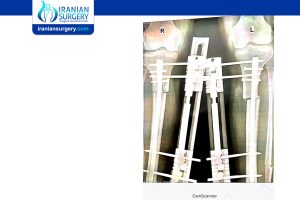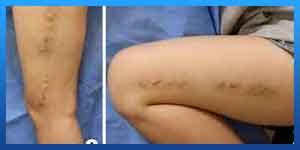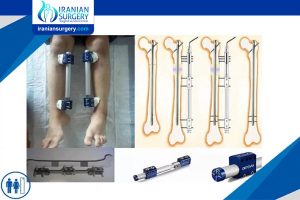Leg lengthening surgery Scar

Does leg lengthening surgery leave scars?
Does limb lengthening surgery leave scars?
Is leg lengthening surgery safe?
Limb lengthening surgery side effects
Like many surgeries, limb lengthening and reconstruction can come with a range of possible complications. These include:

. Infection
. Rapid or delayed bone healing
. Muscle and joint stiffness
. Damaged fixator
. Scarring
. Bent or broken bones
. Nerve and blood vessel injuries
. Blood clots
. Swelling
. Complex regional pain syndrome or compartment syndrome
. Complications related to anaesthesia or allergies to medications.
Read more about : The Swedish patient saved $ 90,000 by choosing Iran over the United States to have leg lengthening surgery.
Read more about : Siavash from Germany talks about his successful experience in leg lengthening surgery in Iran
Scarring
Will leg lengthening scars go away?
There will be scars from the surgery at the incision sites and at the pin and wire sites. Most scars usually fade over time and do not cause any problems.
Sometimes, however, a scar may appear puckered and dimpled. Your child may consider scar revision (treatment to reduce the appearance of scars) at a later time, but most patients choose not to.
Infection
Infection can occur at the pin and wire sites, at the incision sites (where the surgeon opened your child’s skin) or in the bone.
Infections at the pin and wire sites are very common and are considered minor complications. Infections at the incision sites and in the bone are more serious but extremely rare.
Signs of infection include:
. Pain around the pin, wire or incision site
. Warmth around the site
. Redness around the site
. Swelling around the site
. Pus, yellow or green drainage from the site
. Fever (temperature higher than 38.5°C)
Most infections can be treated with oral antibiotics and careful cleaning of the sites. Sometimes, a child may need to be admitted to hospital for IV antibiotics or surgery to change a pin or wire.

To minimize the risk of infection, you will be taught how to care for your pin and wire sites before you leave the hospital.
Read more about : Limb Lengthening Surgery-External Fixators
Read more about : Lengthening over Nails (LON)
Read more about : Is there any age limit for limb lengthening surgery?
Read more about : Is Limb Lengthening Surgery Safe?
__________________________________________________________________________________________________________________________________________
The mission of Iranian Surgery is to put international patients in direct contact with Iranian based medical centers through a user-friendly online platform.
We offer medical consultation to more than 1,500 people every month.
Our website has more than 200,000 monthly visitors.
We cooperate with top Iranian surgeons and hospital to find the best treatment for you.
Rapid or delayed bone healing
Limb lengthening and deformity correction require new bone to form and heal. Sometimes the bone can heal too quickly or too slowly. The health-care team will watch for this using the x-rays taken at each follow-up clinic appointment.
. Healing too quickly
Some people are better at healing bone than others. If a bone heals too quickly during limb reconstruction, it can start to get stuck. This makes it difficult to keep lengthening the limb or correcting the deformity. If an x-ray shows that a bone is healing too quickly, the correction of the bone may need to be sped up simply by adjusting the fixator by a greater amount each day.
. Healing too slowly
Sometimes the bone does not heal fast enough. If an x-ray shows that the bone is not healing well, the correction may need to be slowed down by reducing the amount of adjustments to the fixator each day. This would likely mean wearing a frame for longer than planned.
A situation in which the bone fails to heal is called nonunion. If this seems to be happening, the surgeon may decide to stop or reverse the limb reconstruction or perform further surgery to help heal the bone. Fortunately, nonunion is very rare.
Muscle stiffness and joint contracture
When a limb is being lengthened, both the bone and the muscles attached to it get longer. Muscles that are being lengthened get tight, stiff and sore very quickly. This can lead to difficulty in moving the joint. If a muscle gets too tight and starts to pull on the surrounding joint, the joint can become stiff and even start to dislocate.
If a muscle or joint becomes too stiff, the surgeon will slow down or stop the correction of the bone to allow the joint to regain motion. In rare cases, your child may need surgery to get the joint moving again.
Joint motion is essential for a successful limb lengthening and reconstruction. To avoid any stiffness, your child must follow their physical therapy program.

Damaged fixator
The fixator includes the frame and any pins, screws and wires that keep it in place.
Occasionally, parts of the fixator may bend or break. Most often, your child's health-care team can easily identify and manage any damage at a clinic appointment. If you notice that part of your child's fixator is loose or broken, please contact your child's health-care team.
Bent or broken bones
Newly healed bone can bend when the fixator is on or once it has been removed. Your child's health-care team will use the x-rays at your child's clinic appointments to watch for this.
If the bone starts to bend when the fixator is on, it can be easily corrected by adjusting the fixator in clinic. If the bone bends or breaks when the fixator is removed, your child may need another surgery, which may include applying a new fixator.
Be assured that bending or breaking of the bone after the fixator is removed is very rare. If it does happen, it is most likely to occur in the first year after the fixator is removed.
To help avoid this complication, your child's activities will be modified for one year after the fixator comes off.
Read more about : Does limb lengthening hurt?
Read more about : How Many Centimeters Can I Get after Leg Lengthening Surgery?
Read more about : Limb lengthening recovery time
Read more about : Internal limb lengthening surgery
Read more about : Leg lengthening recovery time
Read more about : Exercises after leg length discrepancy
Nerve and blood vessel injuries
The surgeon will use pins and wires to attach the fixator to the bone in a way that aims to avoid nerves and blood vessels. But there is always a risk of injuring a nerve or blood vessel during surgery. Fortunately, both nerve and blood vessel injuries are extremely rare.
Nerve injury or pain
If a nerve is injured, your child may experience temporary or permanent loss of some feeling or movement. Recovery from nerve injuries is slow and further surgeries may be needed to help the healing.
Nerves are sensitive when stretched and can become painful or lose function during your child's limb lengthening or correction. However, your child's health-care team can identify this easily at follow-up appointments. Slowing down the correction will usually improve any nerve issues, but sometimes the correction may need to be stopped. In rare cases, the nerve may become trapped and need to be released through surgery.
Blood vessel injury
Injured blood vessels, depending on how severe the injury, can cause your child to lose a lot of blood from a limb. In the very rare event that a major blood vessel is damaged, your child will need surgery to repair it.
Blood clots in the leg
A blood clot in a vein of the leg is called a deep vein thrombosis (DVT). These clots can happen in the first few days after surgery. If the clot breaks off and travels to the lungs, it can cause serious problems with breathing.
Less than 1 per cent of patients experience DVT. Your child can reduce the risk of DVT by getting up and moving around after their limb lengthening or correction surgery.
Complex regional pain syndrome (CRPS)
Complex regional pain syndrome occurs when the nerves become over-reactive after surgery. Common symptoms include pain, swelling, stiffness and sensitivity to touch. Treatment usually includes pain medication and physiotherapy. Though extremely rare, CRPS can result in permanent disability.
Compartment syndrome
This rare but painful condition occurs when swelling in the limb stops blood from flowing to the muscles. If compartment syndrome occurs, the surgeon will perform an urgent surgery to release the pressure on the muscles.
Complications related to anaesthesia and allergies to medication
All surgeries come with the risk of complications from anaesthesia or from previously unknown allergies to medications. Before the limb lengthening and reconstruction surgery, our anaesthesia team will discuss any specific risks and complications with you and your child.
When to call your child’s health-care team
Limb lengthening and reconstruction surgery is usually very successful. A major part of that success comes from ongoing communication about your child and their progress with your child's health-care team. Contact the team any time if you have questions or are unsure about your child's wellbeing.
Contact your child's health-care team as soon as possible if your child has specific problems associated with their limb reconstruction surgery. These include:
. A fever higher than 38.5°C
. Swelling, stiffness or sensitivity to touch in the limb
. A change in their ability to move or feel part of their limb
. Pain that is not getting better with prescribed medication
. Pain at a pin, wire or incision site
. Warmth, redness, swelling or pus around a pin, wire or incision site
. A broken or loose part of the fixator
. Trouble adjusting the fixator.
Read more about : Limb Lengthening Surgery Pros and Cons
Read more about : Diagnosis code for leg length discrepancy
Read more about : What is the most common complication of bone lengthening using external fixation?
Read more about : Can my legs become shortened again after leg lengthening surgery?
Read more about : Limb length discrepancy treatment
Read more about : Causes of Limb Length Discrepancy
Read more about : Limb Length Discrepancy Symptoms
Read more about : Limb Length Discrepancy
Read more about : Total knee replacement surgery success story in Iran
Read more about : Kidney transplant in Iran success story in Iran
Read more about : Leg lengthening surgery cost 2021
Read more about : Leg lengthening surgery before and after photos
Read more about : Leg lenthenening surgery sucees story
Read more about : Success rate of limb lengthening surgery
Read more about : Walking after Leg Lengthening Surgery
Read more about : Running after Limb (Leg) Lengthening


